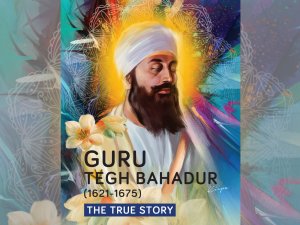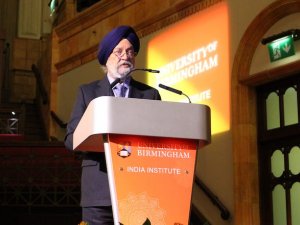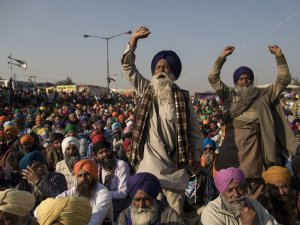The invitation from 1914 Sikhs Directorate read, “On 12th September 2014 the British Army will be hosting an event dedicated to Saragarhi Day and this will also see the launch of the BAFSA (British Armed Forces Sikh Association). This is to be hosted at the prestigious Royal Military Academy, Sandhurst and will culminate in a march past by the 1914 Sikhs platoon.”
It was only after attending this event that I realised how important and historic the occasion was ! More so the following morning, when I turned on the TV. “BBC 24 Hours”, peak time morning news was already showing those awe-inspiring British Singh jawans, resplendent in their First World War uniforms. They filled the TV screen as they marched past, saluted an army general standing next to Lord Indarjit Singh of Wimbledon, and their starting and finishing Jaikaras of “Bole so nihaal....” echoed from the walls of the majestic Academy buildings.
Not only has the British army acknowledged (at last) and “honoured the contribution made by Sikh soldiers during World War One”, but even the British mainstream media has woken up to that historical fact. No longer are the Sikhs lost in generalised labels like “Indians” or “Asians”. They stand tall as “Sikhs”.
Having done some cadet training while at High School in Malaya, I am only too well aware how much training these young 36 Sikh volunteers would have put in to achieve the high standard that they displayed marching up and down the parade ground at Sandhurst.
In the Indian Army Memorial Room, Lord Indarjit Singh delivered a well balanced speech followed by others. With the two visible identity Sikh Lords present - the other being recently appointed Lord Ranbir Singh Suri - all played their part. Many Sikh community leaders, including those from the Sikh Federation UK, were there. There was a a good mix of smartly dressed young Sikh men and women (many of the women wearing turbans also).
It was an opportunity to meet many old and new faces, and to also mix with serving Sikhs in the British army to know more about conditions for turban-wearing Sikhs in the British army, now keen to recruit more turban wearing Sikhs. The target is about 1,000 Sikhs in the next few years. There was one Sikh Squadron Leader from the Royal Air Force with his father who had also served in the RAF on the engineering side.
A short exchange with Lord Ranbir Singh Suri confirmed my own first impression that his cultured presence in the Lords will certainly add to British Sikh influence in the Lords. It was a pleasure meeting him; and a bonus having a photo taken with both Sikh Lords and their wives. (Something for the family album!)
Such a show of British Sikh solidarity as we commemorated the epic battle of Saragarhi, gives us hope for the future that in Britain we will be counted and recognised as “Sikh” and as “British”.
British Sikhs can progress when there is recognition within the community of complementary roles and skills, above personality level. To some extent that is happening around the table of the Sikh Council UK – a sort of 21st Century UK Sarbatt Khalsa facility. (My usual response to those who claim bias in the Council is to join in and redress the perceived imbalance.)
We congratulate those young British Sikhs in uniforms, proud of their Sikh identity. They will continue to show us the way forward, as they march in step to “take part in ceremonial and re-enactment parades during the next 4 years.” (quote from 1914 Sikhs Directorate)
Gurmukh
Singh
(Principal (policy), UK Civil Service ret’d)
Photo: UK Sikh Lords with their wives: Lord Ranbir Singh Suri on left, S. Gurmukh Singh center, Lord Indarjit Singh on right
Links:
Anglo-Sikh Relations & World War 1" serial for Panjab Times (UK)





